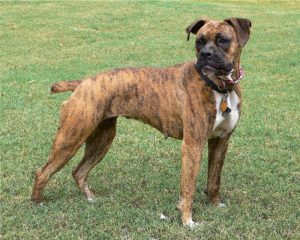19.6: Brindle color - partial dominance and epistasis
- Page ID
- 70697
Brindle coloration is a black and brown striping pattern that is caused by different alleles at the “K locus”, which is probably a gene called ASIP that controls pigment switching (Figure \(\PageIndex{1}\); Ciampolini, 2013). There are three alleles of the K locus: KB, kbr, and ky (Kerns, 2007). The KB allele is dominant over the other two alleles and produces solid black color. kbr produces the brindle color pattern and is dominant over the ky allele. This means that dogs with the genotype kbrkbr or kbrky will have the brindle color pattern. Dogs with the genotype kyky are yellow in color.

The K locus and MC1R (which controls the difference between dark eumelanin and light pheomelanin production) have an epistatic relationship. If a dog has two recessive alleles for MC1R and is therefore unable to make eumelanin, the dog will appear yellow regardless of its genotype at the K locus.
References
Unless otherwise noted, text and images by Lisa Bartee, 2016.
Ciampolini R, Cecchi F, Spaterna A, Bramante A, Bardet SM, Oulmouden A. 2013. Characterization of different 5′-untranslated exons of the ASIP gene in black-and-tan Doberman Pinscher and brindle Boxer dogs. Anim Genet. 44(1):114-7.
Kerns JA, Cargill EJ, Clark LA, Candille SI, Berryere TG, Olivier M, Lust G, Todhunter RJ, Schmutz SM, Murphy KE, Barsh GS. 2007. Linkage and segregation analysis of black and brindle coat color in domestic dogs. Genetics. 176(3):1679-89.

